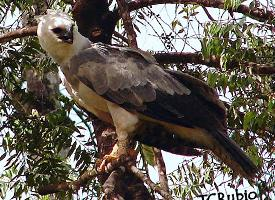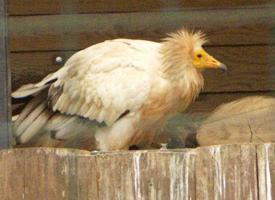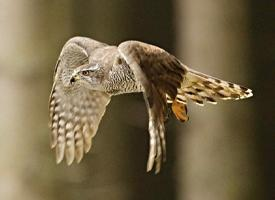
Váhy a míry
| Hmotnost | 9 kg |
|---|---|
| Délka rozpětí křídel | 2 m |
Popis zvířete
The Harpy Eagle (Harpia harpyja), a majestic and powerful bird of prey, reigns supreme in the dense rainforests of Central and South America. This raptor is not only one of the largest eagle species in the world but also an embodiment of strength and grace, making it a fascinating subject of admiration and study.With a formidable size, the Harpy Eagle possesses a wingspan that can reach up to 2 meters (about 6.5 feet) and a body length ranging from 86 to 107 centimeters (34 to 42 inches). Despite their large size, their wings are relatively short and broad, a design perfectly suited for maneuvering through the dense canopy of rainforests. The females are notably larger than the males, a common trait in birds of prey, which allows them to target larger prey.
The plumage of the Harpy Eagle is striking, with a slate-grey coloration on the upper parts and a contrasting pure white below. The bird's head is adorned with a distinctive double crest of feathers that can be raised or lowered depending on its mood. The fierce, penetrating eyes are set in a facial disk of grey feathers, enhancing their keen eyesight which is essential for hunting in the shadowy undergrowth of their forest habitat.
Harpy Eagles are apex predators in their ecosystem, specializing in hunting arboreal mammals. Their diet primarily consists of tree-dwelling animals such as sloths and monkeys, which they capture with astonishing precision and power. The eagle's talons are among the most formidable in the avian world; large, powerful, and capable of exerting tremendous pressure, they ensure the eagle can grasp and subdue its prey with ease. These talons are comparable in size to a grizzly bear's claws, highlighting the eagle's prowess as a hunter.
Breeding pairs of Harpy Eagles are highly territorial and monogamous, often maintaining the same territory throughout their lives. Their nests are enormous structures built high in the canopy, requiring trees strong enough to support the weight of the nest, the adult birds, and their offspring. Breeding is a slow process, with the female typically laying only one or two eggs every two to three years. Both parents are involved in rearing the chick, which depends on them for up to ten months, a testament to the extended care and investment required to raise such a powerful bird.
The Harpy Eagle's role in its ecosystem cannot be overstated; as a top predator, it helps maintain the balance of species populations within its rainforest home. However, this magnificent bird faces threats from habitat destruction due to logging, agriculture, and expanding human settlements. Additionally, they are sometimes killed by humans who see them as a threat to livestock or for sport.
Conservation efforts are underway in several countries to protect the Harpy Eagle and its habitat. These include breeding programs, education initiatives to raise awareness of the species' importance, and the creation of protected areas to ensure the survival of these magnificent birds for future generations to marvel at and study.
In summary, the Harpy Eagle is a symbol of the wild, untamed beauty of the rainforests of Central and South America. Its presence indicates a healthy, intact ecosystem, and its conservation is essential for maintaining the biodiversity of these critical habitats. The Harpy Eagle, with its awe-inspiring appearance, formidable hunting skills, and complex behaviors, continues to be one of the most remarkable and iconic birds in the avian world.
Podobná zvířata
Nové fotografie zvířat
Top 10 zvířat
- Chinese water dragon (Physignathus cocincinus)
- Galápagos tortoise (Geochelone nigra complex)
- Dolphin gull (Leucophaeus scoresbii)
- Japanese macaque (Macaca fuscata)
- Colombian red howler (Alouatta seniculus)
- Sea urchins (Echinoidea)
- Moustached guenon (Cercopithecus cephus)
- Diana monkey (Cercopithecus diana)
- Common reed warbler (Acrocephalus scirpaceus)
- Common house mosquito (Culex pipiens)


